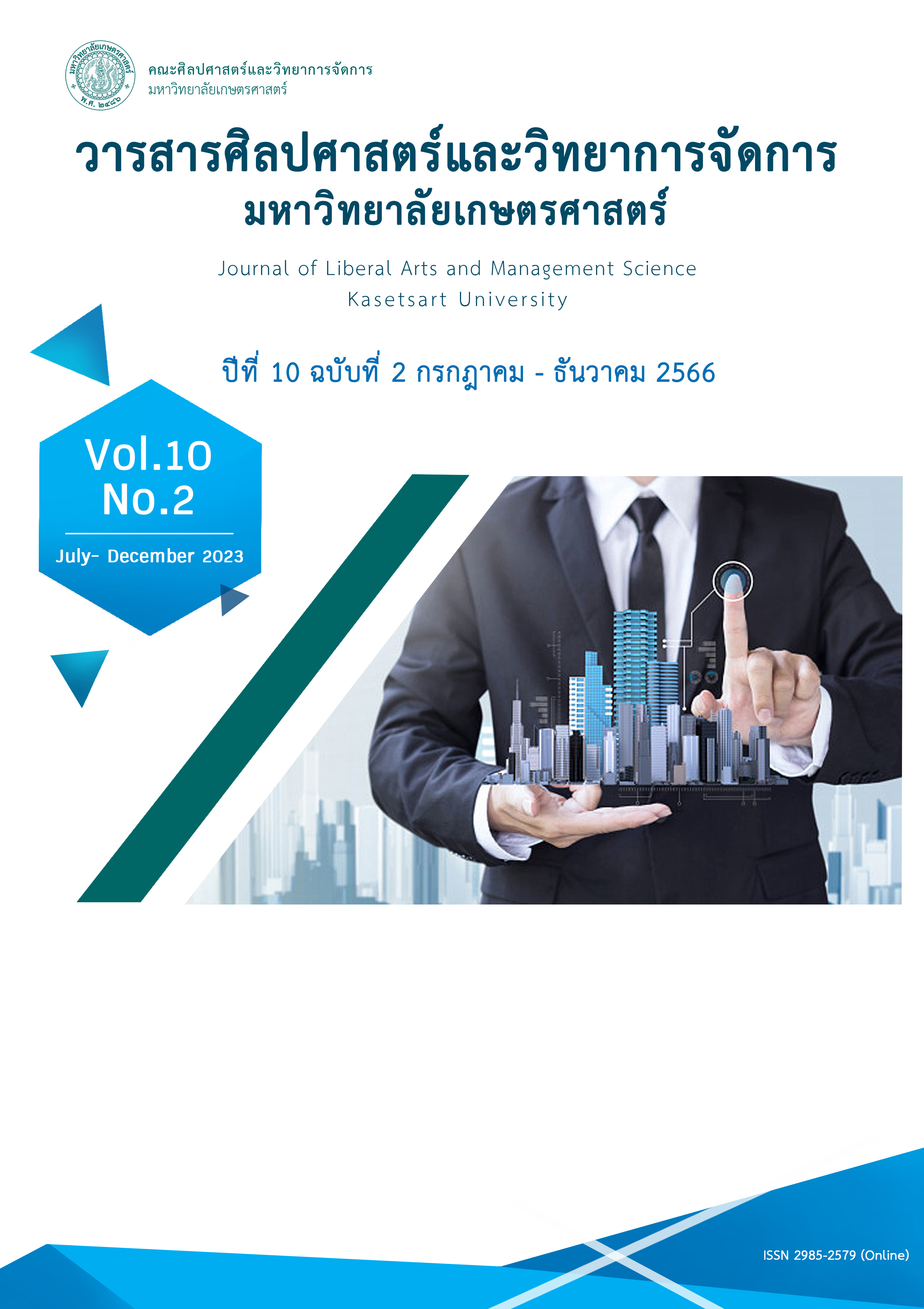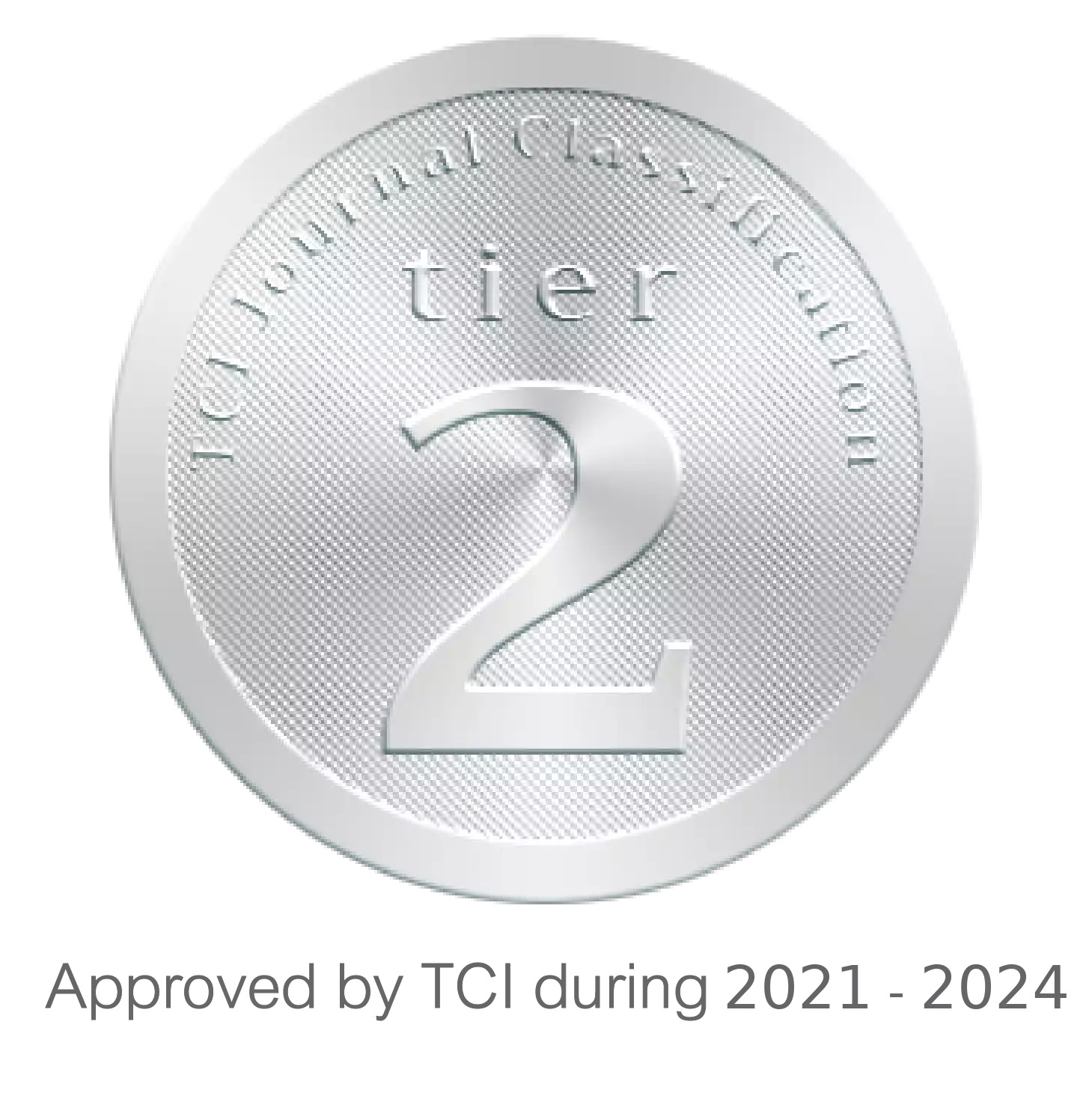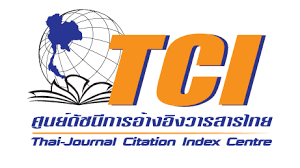การตอบสนองทางอารมณ์ของการวางผลิตภัณฑ์ประกอบฉากในซีรีส์เกาหลี กรณีศึกษา การตัดสินใจซื้อผลิตภัณฑ์ความงามในกลุ่มเจเนอเรชั่นซี
คำสำคัญ:
ความสอดคล้องของแบรนด์และซีรีส์, ความคุ้นเคยในแบรนด์, การตอบสนองทางอารมณ์, การตัดสินใจซื้อ, โฆษณาแฝง, ซีรีส์เกาหลีบทคัดย่อ
การวิจัยนี้มีวัตถุประสงค์เพื่อศึกษาปัจจัยที่ส่งผลต่อการตอบสนองทางอารมณ์ของการวางผลิตภัณฑ์ประกอบฉากในซีรีส์เกาหลีและการตัดสินใจซื้อผลิตภัณฑ์ความงาม กลุ่มตัวอย่างในการศึกษา จำนวน 420 คน เป็นกลุ่มเจเนอเรชั่นซี อายุระหว่าง 18 - 25 ปี งานวิจัยนี้เป็นวิจัยเชิงปริมาณ เก็บรวบรวมข้อมูลโดยใช้แบบสอบถามออนไลน์ และนำข้อมูลมาวิเคราะห์โดยใช้สถิติเชิงพรรณนา และการทดสอบสมมติฐานผ่านการวิเคราะห์ข้อมูลโดยใช้สถิติเชิงอนุมาน ผลการศึกษาพบว่า ความสอดคล้องของแบรนด์และซีรีส์เกาหลีส่งผลต่อการตัดสินใจซื้อผลิตภัณฑ์และความคุ้นเคยในแบรนด์ส่งผลต่อการตัดสินใจซื้อผลิตภัณฑ์ความงาม และการตอบสนองทางอารมณ์ส่งผลต่อการตัดสินใจซื้อผลิตภัณฑ์ความงามเช่นกัน การศึกษาครั้งนี้ยังตรวจสอบผลกระทบทางตรงและทางอ้อมของปัจจัยความสอดคล้องของแบรนด์และซีรีส์ และปัจจัยความคุ้นเคยในแบรนด์ส่งผลต่อการตัดสินใจซื้อผลิตภัณฑ์ความงาม โดยมีปัจจัยการตอบสนองทางอารมณ์เป็นตัวแปรคั่นกลาง ผลการศึกษาพบว่า ตัวแปรคั่นกลางมีอิทธิพลต่อการตัดสินใจซื้อผลิตภัณฑ์ความงาม การศึกษาครั้งนี้ให้ข้อมูลเพิ่มเติมสำหรับนักการตลาดและผู้ประกอบการนำไปใช้เป็นแนวทางการวางผลิตภัณฑ์ความงามประกอบในฉาก
ให้สอดคล้องกับพฤติกรรมและความต้องการของกลุ่มคนเจเนอเรชั่นซี โดยพิจารณาการออกแบบผลิตภัณฑ์สื่อประกอบฉากที่สอดคล้องกับเนื้อเรื่องของซีรีส์ สร้างความคุ้นเคยในแบรนด์ พัฒนากลยุทธ์การวางผลิตภัณฑ์ประกอบฉากในซีรีส์ เพื่อให้ผู้บริโภคเกิดการตอบสนองทางอารมณ์ในเชิงบวก
##plugins.generic.usageStats.downloads##
เอกสารอ้างอิง
กัลยา วานิชย์บัญชา. (2554). สถิติสำหรับงานวิจัย (พิมพ์ครั้งที่ 6). กรุงเทพมหานคร: ธรรมสาร.
วรกร คุรุวงศ์วัฒนา. (2564). การศึกษาการรับรู้และจดจำโฆษณาแฝงประเภทน้ำแร่ในละครซิทคอมของกลุ่ม Generation X (วิทยานิพนธ์ปริญญาการจัดการมหาบัณฑิต). มหาวิทยาลัยมหิดล.
ศิริกุล สัมฤทธิ์นันท์. (2562). ความสัมพันธ์ระหว่างภาพลักษณ์ตราสินค้ากับพฤติกรรมการซื้อเครื่องสำอางเกาหลีของผู้บริโภคในกรุงเทพมหานคร (การศึกษาค้นคว้าอิสระปริญญาบริหารธุรกิจมหาบัณฑิต). มหาวิทยาลัยเทคโนโลยีราชมงคลกรุงเทพ.
ศิริวรรณ เสรีรัตน์. (2541). การบริหารการตลาดยุคใหม่. กรุงเทพมหานคร: ธีระฟิลม์และไทเท็กซ์
สุมิตรา ดีธรรม. (2561). การรับรู้การสื่อสารทางการตลาดผ่านเครือข่ายสังคมออนไลน์เฟซบุ๊กที่มีผลต่อความภักดีของผลิตภัณฑ์เครื่องสำอางลอรีอัล (วิทยานิพนธ์บริหารธุรกิจมหาบัณฑิต). มหาวิทยาลัยรังสิต.
เสรี วงษ์มณฑา. (2548). หลักการโฆษณา. กรุงเทพมหานคร: บริษัท ธรรมสาร จำกัด.
สำนักบริหารการทะเบียน กรมการปกครอง. (2565). สถิติประชากรทางการทะเบียนราษฎร. สืบค้นเมื่อ 20 กันยายน 2566, จาก https://stat.bora.dopa.go.th/stat/statnew/statMONTH/statmonth/#/displayData
Advincula, B. A., Bernardo, M., & Soriano, A. N. (2021). Measuring the influence of product placements in Korean dramas on the act of purchase of Filipino audiences. Journal of Business and Management Studies, 3(2), 268-275.
Augusta, E. D., Mardhiyah, D., & Widiastuti, T. (2019). Effect of country-of-origin image, product knowledge, brand familiarity to purchase intention Korean cosmetics with information seeking as a mediator variable: Indonesian women’s perspective. Dermatology Reports, 11(s1), 7-10.
Baron, R. M., & Kenny, D. A. (1986). The moderator–mediator variable distinction in social psychological research: Conceptual, strategic, and statistical considerations. Journal of personality and social psychology, 51(6), 1173.
Belch, G. E., & Belch, M. A. (2015). Advertising & promotion: An integrated marketing communications perspective (10th ed.). New York: McGraw-Hill Education.
Blackwell, R. D., Miniard, P. W., & Engel, J. F. (2001). Consumer behavior (9th ed.). South-Western Thomas Learning.
Campbell, M. C., & Keller, K. L. (2003). Brand familiarity and advertising repetition effects. Journal of consumer research, 30(2), 292-304.
Cauberghe, V., & De Pelsmacker, P. (2010). The effectiveness of telescopic ads delivered via interactive digital television: The impact of the amount of information and the level of interactivity on brand responses. Journal of Interactive Marketing, 24(4), 297-308.
Cheon, M., Ahn, Y., Mo, J. H., & Park, J. S. (2016). Product-story congruence and actor attractiveness in product placements in television drama. Journal of Fashion Business, 20(3), 104-118.
Chernikova, A., & Branco, M. (2019). Product placement in computer/video games: An analysis of the impact on customers purchasing decision. Innovative Marketing, 15(3), 60.
Choi, S. M., & Rifon, N. J. (2012). It is a match: The impact of congruence between celebrity image and consumer ideal self on endorsement effectiveness. Psychology & marketing, 29(9), 639-650.
Cochran, W. G. (1977). Sampling techniques (3rd ed.). John Wiley & Sons.
Consoli, D. (2009). Emotions that influence purchase decisions and their electronic processing. Annales Universitatis Apulensis Series Oeconomica, 11(2), 996-1008.
Consoli, D. (2010). A new concept of marketing: The emotional marketing. BRAND. Broad Research in Accounting, Negotiation, and Distribution, 1(1), 52-59.
Franzak, F., Makarem, S., & Jae, H. (2014). Design benefits, emotional responses, and brand engagement. Journal of Product & Brand Management, 23(1), 16-23.
Gürses, I. Ö. A., & Okan, E. Y. (2014). Effectiveness of product placement: An experimental study in Turkey. Canadian Social Science, 10(1), 56.
Hadinejad, A., Moyle, B. D., Scott, N., & Kralj, A. (2019). Emotional responses to tourism advertisements: the application of FaceReader™. Tourism Recreation Research, 44(1), 131-135.
Halim, T. M., & Kiatkawsin, K. (2021). Beauty and celebrity: Korean entertainment and its impacts on female Indonesian viewers’ consumption intentions. Sustainability, 13(3), 1405.
Hosany, S. (2012). Appraisal determinants of tourist emotional responses. Journal of travel Research, 51(3), 303-314.
Hosany, S., & D. Gilbert. (2010). Measuring tourists’ emotional experiences toward hedonic holiday destinations. Journal of Travel Research, 49(4): 513-26.
Huber, F., Eisele, A., & Meyer, F. (2018). The role of actual, ideal, and ought self‐congruence in the consumption of hedonic versus utilitarian brands. Psychology & Marketing, 35(1), 47-63.
Hyun, S. S., Kim, W., & Lee, M. J. (2011). The impact of advertising on patrons’ emotional responses, perceived value, and behavioral intentions in the chain restaurant industry: The moderating role of advertising-induced arousal. International Journal of Hospitality Management, 30(3), 689-700.
Ju, H. (2020). Korean TV drama viewership on Netflix: Transcultural affection, romance, and identities. Journal of international and intercultural communication, 13(1), 32-48.
Jung, J., & Hwang, C. S. (2016). Associations between attitudes toward cosmetic surgery, celebrity worship, and body image among South Korean and US female college students. Fashion and Textiles, 3(1), 1-14.
Kent, R. J., & Allen, C. T. (1994). Competitive interference effects in consumer memory for advertising: The role of brand familiarity. Journal of Marketing, 58(3), 97-105.
Kim, J., Choi, D., & Kim, H. (2019). Advertising nativeness as a function of content and design congruence. International Journal of Advertising, 38(6), 845-866.
Korean Culture and Information Centre. (2559). Contemporary Korean No.1 The Korean Wave: A New Pop Culture Phenomenon. Retrieved 20 September 2566, from https://www.ditp.go.th/contents _attach/154036/154036.docx
Kotler, P. & Keller, K. L. (2012). Marketing management (14th ed). Pearson Education Limited.
Krishnan, H. S. (1996). Characteristics of memory associations: A consumer-based brand equity perspective. International Journal of research in Marketing, 13(4), 389-405.
Lee, M. J. (2020). Touring the land of romance: Transnational Korean television drama consumption from online desires to offline intimacy. Journal of Tourism and Cultural Change, 18(1), 67-80.
Liu, Z., Pan, D., & Xu, Y. (2019). The effect of drama types and brand familiarity on brand attitude in brand placement. American Journal of Industrial and Business Management, 9(03), 491.
Machleit, K. A., & Wilson, R. D. (1988). Emotional feelings and attitude toward the advertisement: The roles of brand familiarity and repetition. Journal of advertising, 17(3), 27-35.
Mau, G., Silberer, G. & Constien, C. (2008). Communicating brands playfully: Effects of in-game advertising for familiar and unfamiliar brands. International Journal of Advertising, 27(5), 827-851.
Merchant, A., & Rose, G. M. (2013). Effects of advertising evoked vicarious nostalgia on brand heritage. Journal of Business Research, 66(12), 2619-2625.
Middelesch, T. (2017). Instagram, advertising on a level playing field? The effect of brand familiarity and advertisement vividness (Master's thesis). University of Twente.
Nugroho, S. D. P., Rahayu, M., & Hapsari, R. D. V. (2022). The impacts of social media influencer’s credibility attributes on gen Z purchase intention with brand image as mediation: Study on consumers of Korea cosmetic product. International Journal of Research in Business and Social Science, 11(5), 18-32.
Puccinelli, N. M., Goodstein, R. C., Grewal, D., Price, R., Raghubir, P., & Stewart, D. (2009). Customer experience management in retailing: Understanding the buying process. Journal of retailing, 85(1), 15-30.
Radha, G., & Jija, P. (2013). Influence of celebrity endorsement on the consumer's purchase decision. International journal of scientific and research publications, 3(11), 1-28.
Sitorus, R. X., Mani, L., Oktiano, D., & Amalia, Y. (2023). Influence of Indonesian product placement in Koream drama series to buy interest through brand familiarity as a mediator. Jurnal Darma Agung, 31(1), 932-942.
Steenkamp, J. B., Batra, R., & Alden, D. L. (2003). How perceived brand globalness creates brand value. Journal of international business studies, 34, 53-65.
TNP. (2022). Marketing Research วิจัยตลาดความงามในประเทศไทย. สืบค้นเมื่อ 20 กันยายน 2566, จาก https://www.tnpoem.com/content/6295/ marketing-research
Trazy. (2020). Must-Have Korean Cosmetics in K-Dramas 2019-2020. Retrieved 20 September 2566, from https://blog.trazy.com/must-have-korean-cosmetics-in-k-dramas/
Urban Creature. (2022). อุตสาหกรรมบันเทิง เศรษฐกิจหลักเกาหลี หมัดเด็ดจากรัฐบาล. สืบค้นเมื่อ 20 กันยายน 2566, จาก https://urbancreature.co/ southkorea-koreanwave/
Visinescu, L. L., Sidorova, A., Jones, M. C., & Prybutok, V. R. (2015). The influence of website dimensionality on customer experiences, perceptions, and behavioral intentions: An exploration of 2D vs. 3D web design. Information & Management, 52(1), 1-17








